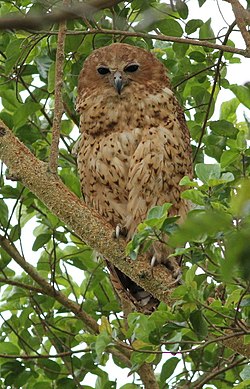Pel's fishing owl
| Pel's fishing owl | |
|---|---|
 |
|
| Adult | |
| Scientific classification | |
| Kingdom: | Animalia |
| Phylum: | Chordata |
| Class: | Aves |
| Order: | Strigiformes |
| Family: | Strigidae |
| Genus: | Scotopelia |
| Species: | S. peli |
| Binomial name | |
|
Scotopelia peli (Bonaparte, 1850) |
|
The Pel's fishing owl (Scotopelia peli) is a large species of owl in the family Strigidae. It feeds nocturnally on fish and frogs snatched from the surface of lakes and rivers. The species prefers slow moving rivers with large overhanging trees to roost and forage from. It nests in hollows and the forks of large trees. Though two eggs are laid, only one chick is raised.
Pel's fishing owl is one of the largest owl species in the world. Among the world's owls, it ranks as the fifth heaviest on average, the seventh longest in length and measured wing chord and fourth longest in mean wingspan, although not all large species have had measured wingspans. It measures 51–63 cm (20–25 in) in length, spans around 153 cm (60 in) across the wings and weighs 2–2.35 kg (4.4–5.2 lb). Under current classification, it is the heaviest extant owl outside of the Bubo genus, although some authors may also include the fishing owls in Bubo. Among standard measurements, the wing chord is 40.7–44.7 cm (16.0–17.6 in) and the tail is 20.7–24.3 cm (8.1–9.6 in) long. They are well adapted to their aquatic lifestyle. Unlike most owls, they have minimal feathering on the toes and the tarsus, thus minimizing the amount of plumage that gets wet while fishing. Like diurnal raptors that specialize in fish, they have spiky scales on the bottoms of their feet that help them grip slippery fish. Since hearing and auditory stealth is not important to its hunting techniques, this owl does not have strong hearing and does not have the soft edges to its flight feathers that most owls share, which makes them almost impossible to hear in flight.
Adults are rich ginger-rufous with dense dark bars to the upperparts and scaling to the underparts. The feathers around the head are loose and long, giving the head a shaggy appearance. The tarsi and toes are unfeathered and straw-colored. The white throat is often largely obscured but can be puffed up in displaying birds during courtship. The flight and tail feathers are barred with lighter and darker feathers. The eyes are distinctly dark, often blackish in color. The two adult sexes are similar looking but females are generally less rufous in color and have a more indistinct facial disc. There is considerable variation in coloration and barring in adult birds, with some birds having extensive pale feathers with others having several blackish markings. Juveniles are more uniform buff than adults. Unlike the eagle-owls, the ear tufts of the Pel's fishing owl are barely visible, giving it a very round-headed appearance. The two related fishing owls are smaller and lack the dark barring and scaling (though they do have dark streaks below).
...
Wikipedia

